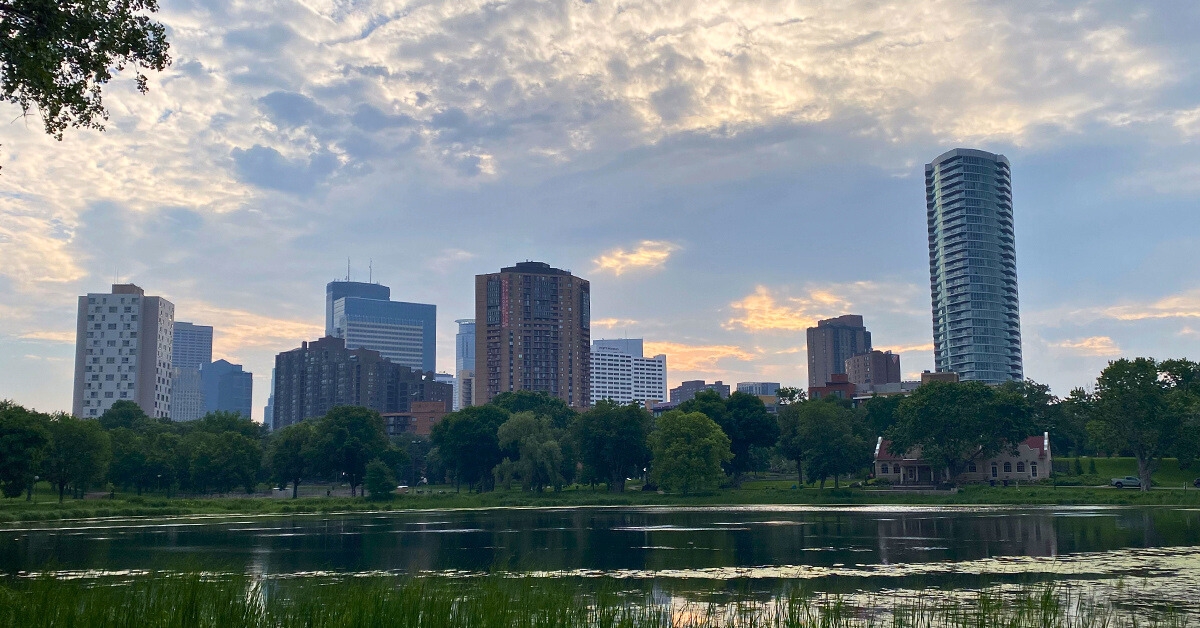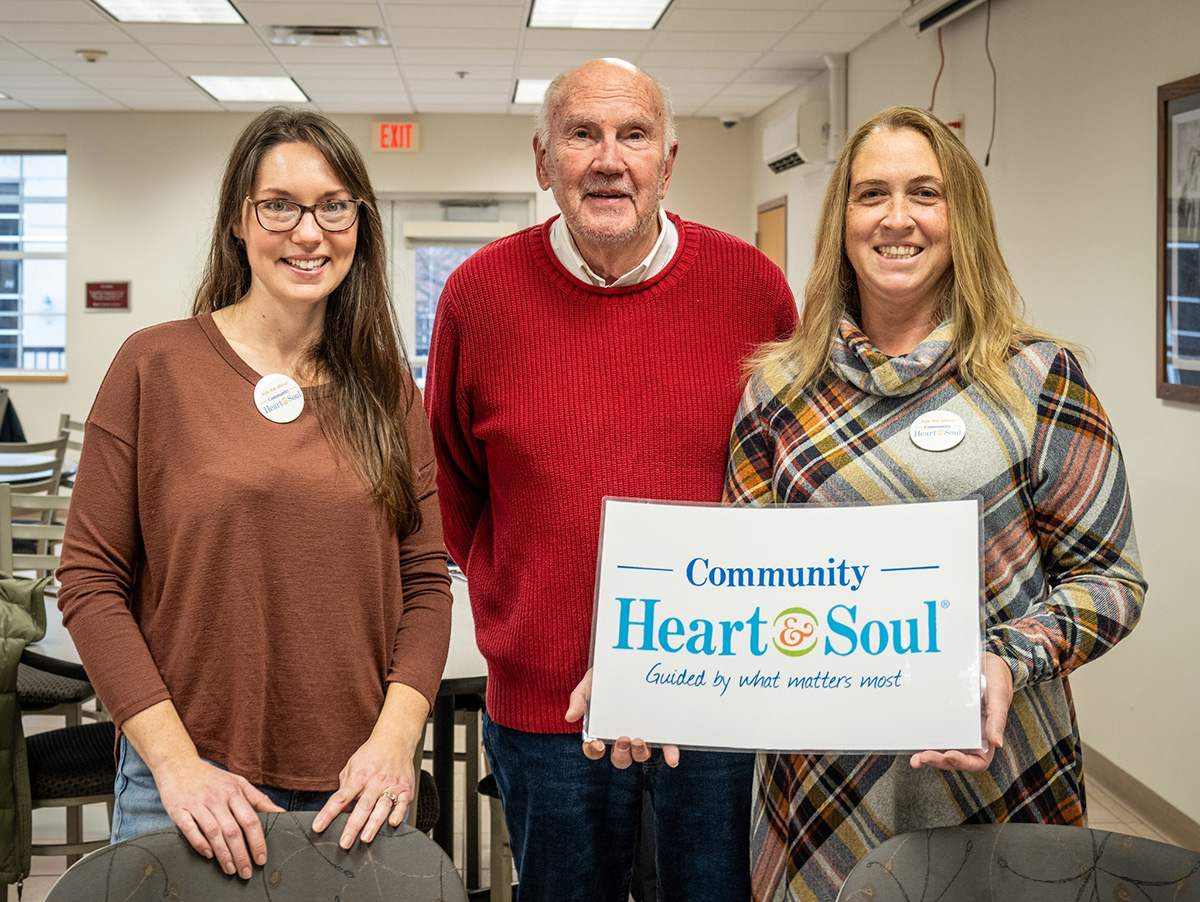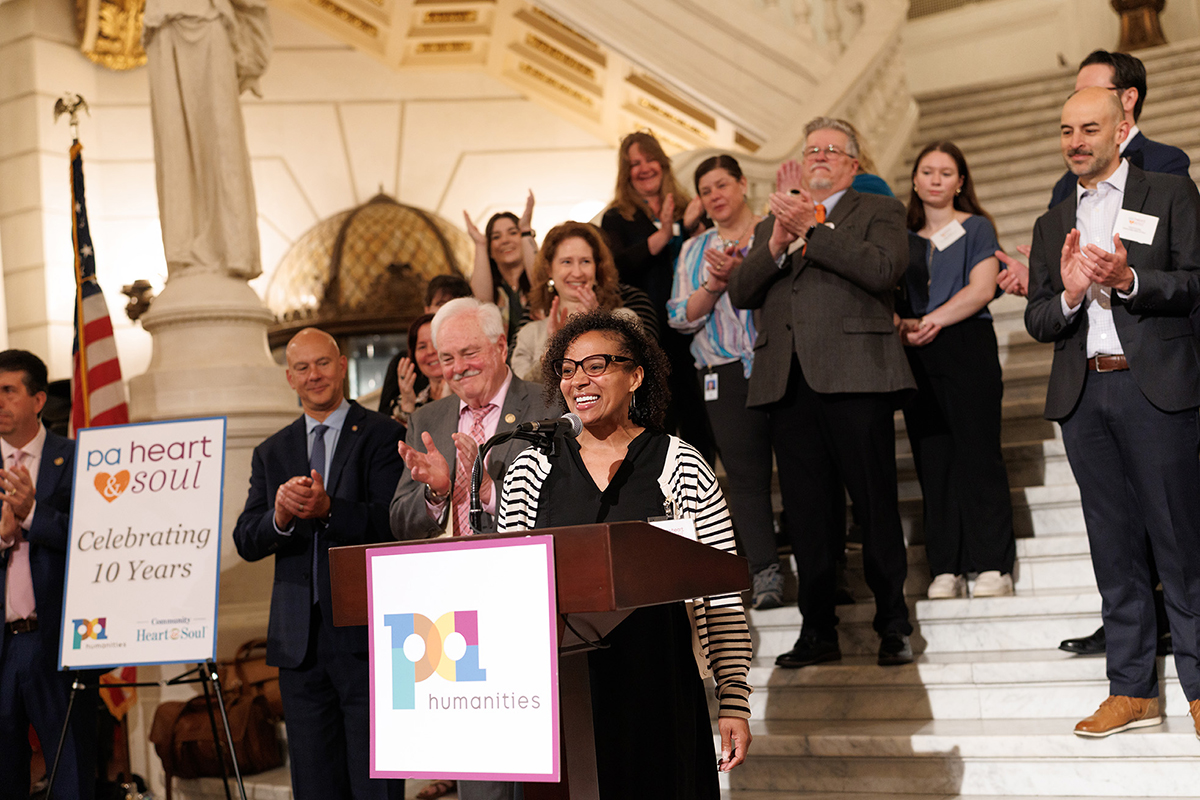How One Small Ohio Town Practices Democracy
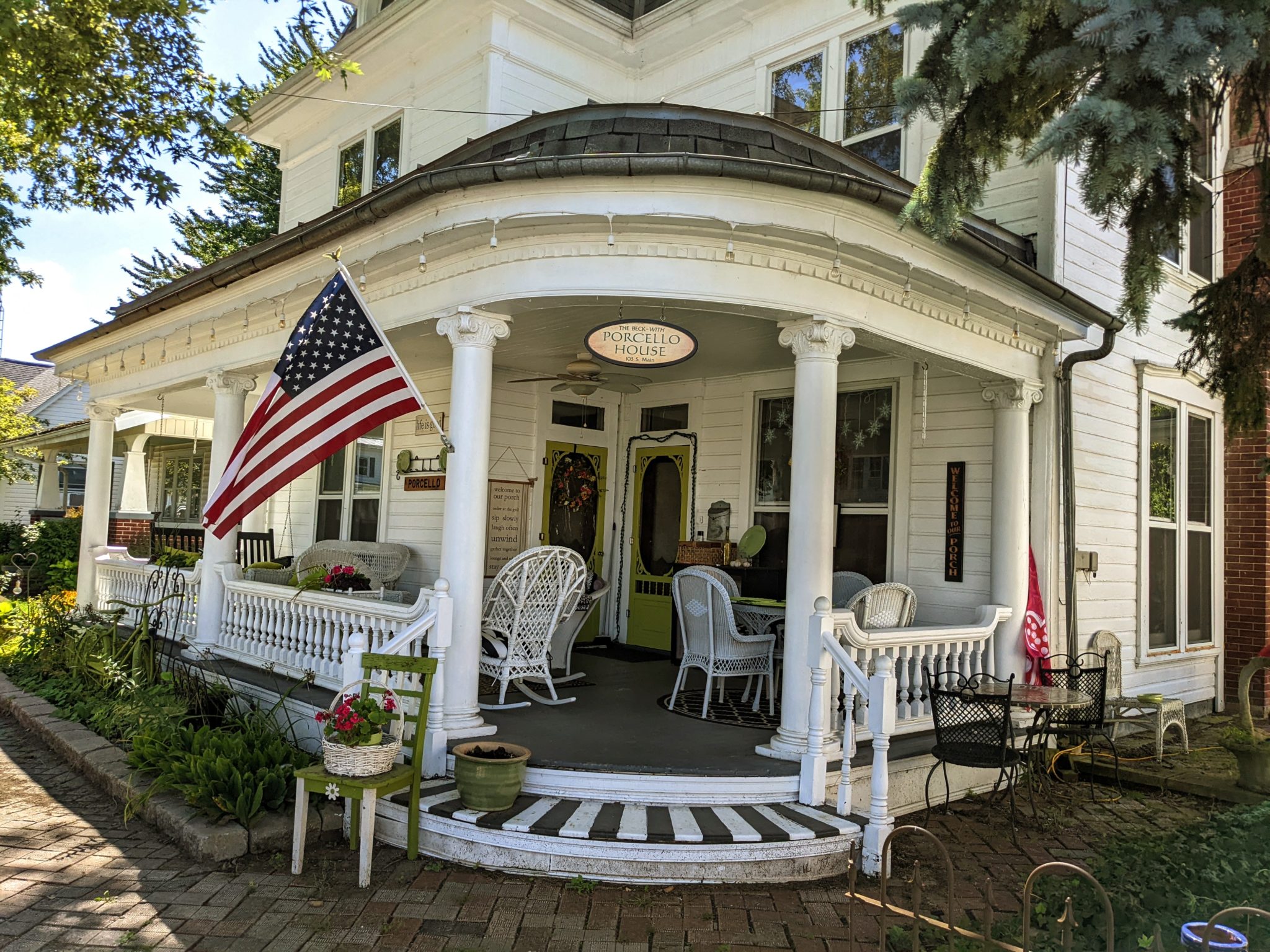
This article first appeared on the Our Towns Civic Foundation website on October 24, 2022, which you can see here.
Small is Big in Mount Blanchard, Ohio.
Growing up in small-town Ohio, I often used water towers as a compass, my version of celestial navigation. Driving across farmland from town to town, you see the towers looming, many of them with a city name or civic slogan, reassuring you that you’re on the right country road and heading in the right direction.
My hometown of Vermilion sits on the south shore of Lake Erie. Its classic globe-shaped water tower is planted near the railroad bridge that spans the river. Bold dark letters, VERMILION, arch over the top. The image of an anchor secures the middle. The word SAILORS arches underneath it. Sailors, as you could guess, is the mascot for the Vermilion High School teams.
Fast forward to well beyond high school as Jim and I were driving this summer through farmlands in northwest Ohio, heading for Mount Blanchard, a town of 500 people about 60 miles south of Toledo. We passed crossroads that lead to more small towns and more farmland. We judged our approach as we caught sight of the water tower of Mount Blanchard. The tower, we learned later, was a proud and critical addition to the town’s infrastructure improvements made years earlier.
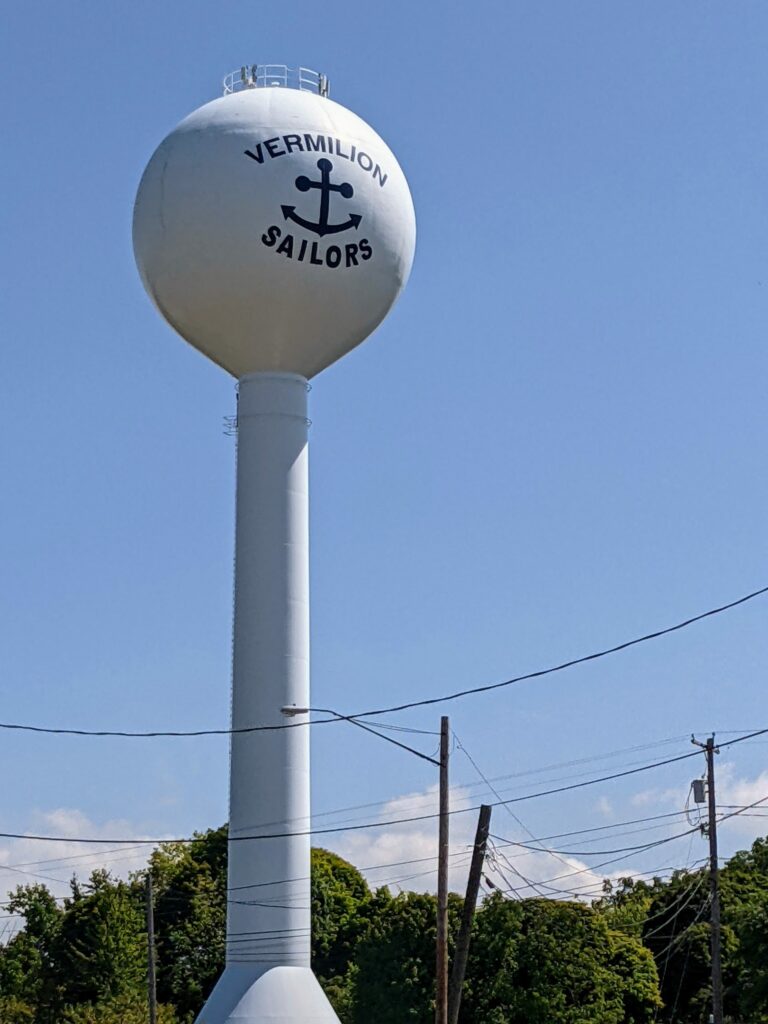
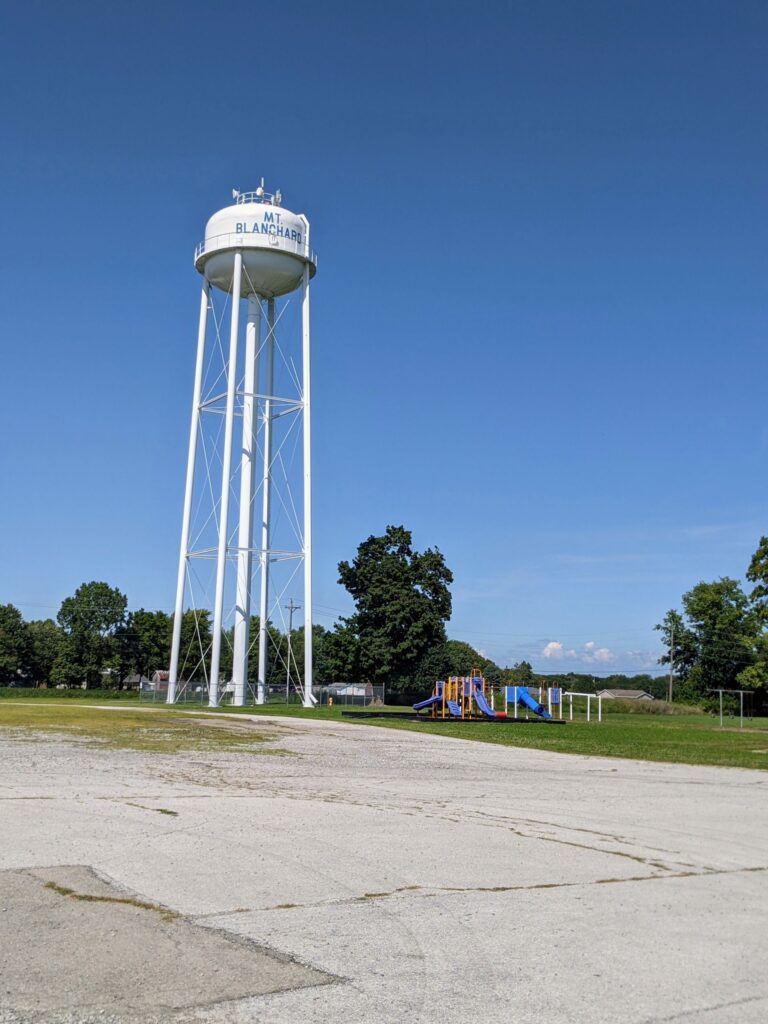
We heard that there was a lot more to Mount Blanchard than its major improvements and its street-level classic Midwest charm, and that this town was a model for change, much of it community-driven. We found Jackie Porcello, a dynamo of civic energy, on the big wraparound porch of her Main Street Victorian house to hear the story.
Mount Blanchard approached change in two ways. One was through various government grants for big-ticket items like the new water tower, the sidewalks, street lamps, a gazebo, and the less-sexy sewer lines. A second approach was to adopt a resident-led, citizen-involved process called Community Heart & Soul® (CH&S), which we had seen in practice earlier in Maine, southern Pennsylvania, Illinois, and South Carolina (upcoming). We were impressed before, and wanted to see more. (Community Heart & Soul is an Our Towns partner and supporter.)
After a few hours rocking on the front porch, Porcello suggested we zip around town in her golf cart for an illustrated version of her stories. We drove past the familiar inventory of sites: the cemetery, the churches, the mayor’s residence, the house where Porcello grew up, the site of the former school. Curiously, a boast of many towns about churches is having more of them per capita than any other town in the country; we heard that in South Carolina, in California, in Ohio (several times), and elsewhere. Who knows? There was also a marker to Johnny Appleseed, who once owned property and planted apple trees in Mount Blanchard.
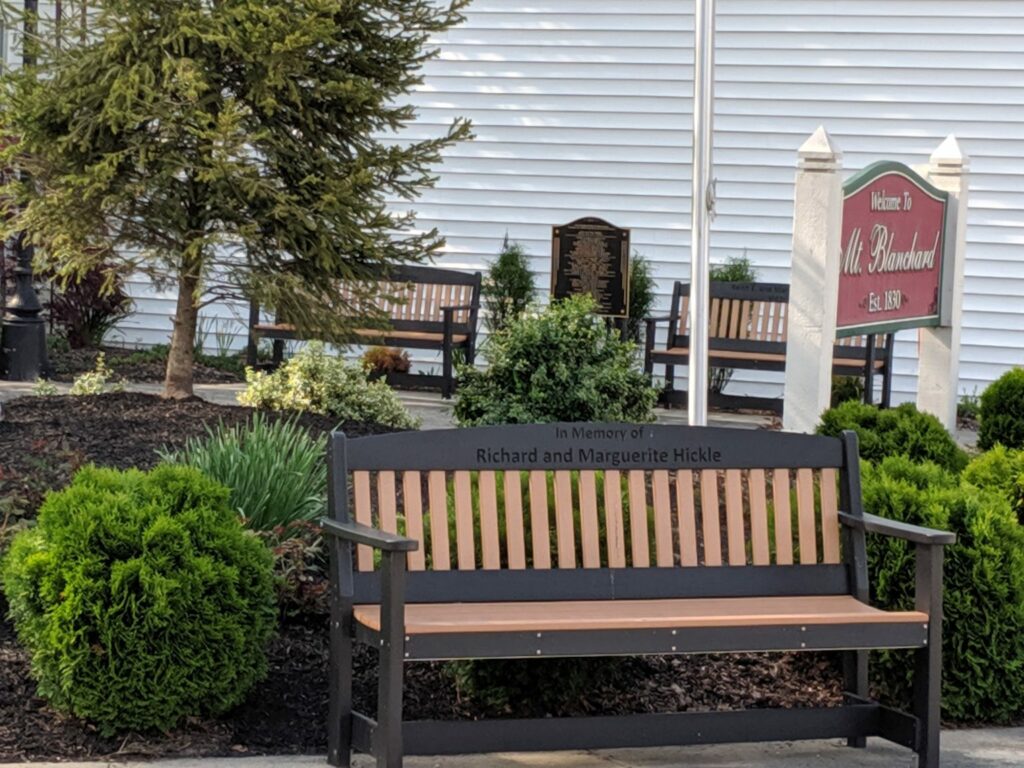
We walked around Hurricane Park, named for the original school mascot, with its late-summer landscaping and gazebo in the foreground of the new water tower. Along the park’s edge was a most unusual, surprising digital rotating LED sign. Such signs catch your eye. There is one that I studied with interest when we lived in Shanghai that offered a moveable feast of time, date, temperature, number of available parking spots in various lots, and the decibel level of passing traffic.
The LED sign in Mount Blanchard was somewhat controversial, since it is so bright and green and seems out of character in its surroundings. But as Porcello described, the sign’s great benefit is as a source of information, especially in a town with no local newspaper. The sign keeps residents abreast of events like the schedule for the farmers market, or the upcoming community lunch for kids before the first day of school. It stands right on Main Street, in sight of everyone in town going anywhere, or of outsiders passing through who might be interested in local happenings.
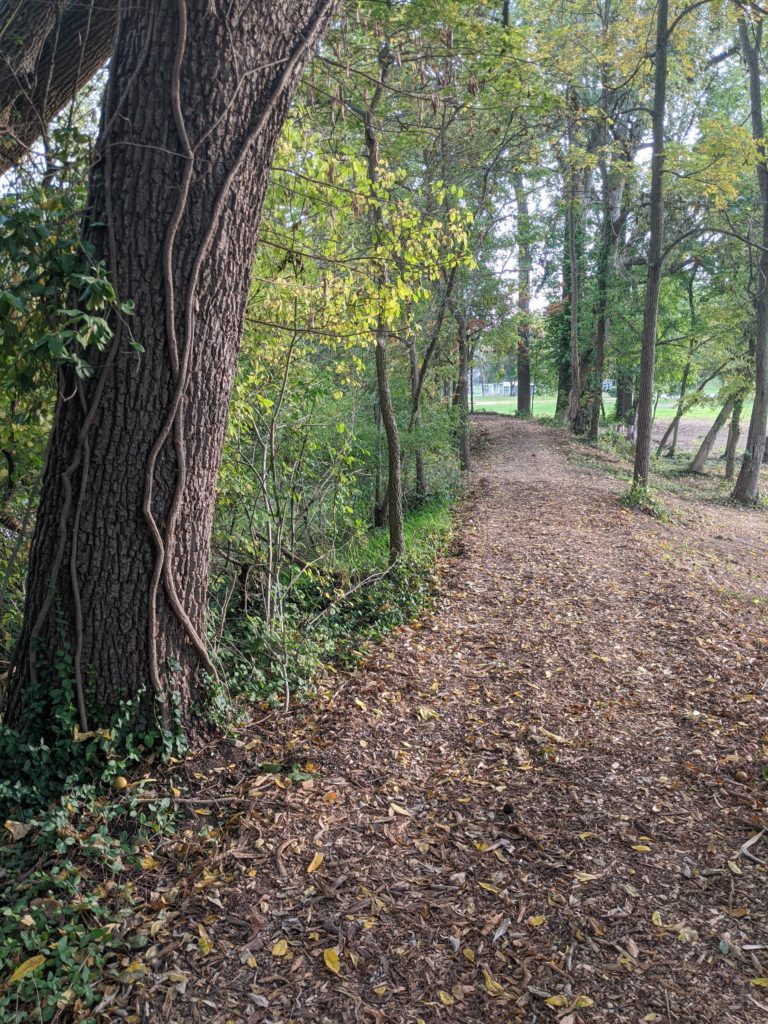
Three particular points of town pride caught my attention: the public swimming pool; the surrounding sprawling recreation area called Island Park; and the Heritage Trail, a hiking trail in development, which meanders through downtown and over to the river. We have seen such quality-of-life improvements in towns that speak to top-of-mind issues, like keeping young families happy, and serving as a drawing card for potential new residents, and as a dedicated gathering place for the youth. We’ve written about river walks in countless towns and cities, which has led to a favorite family mantra, “Every successful town has a river walk, even if it doesn’t have a river.” Mount Blanchard’s “river walk” was proving the point once again.
Downtown Main Street looked like a work still in progress: some shops were boarded up; others were abandoned. Here used to be a grocery store; there used to be a bank. But changes were also notable. On one corner was a small pop-up park and across the street another landscaped park with flagpoles and a veterans memorial marker. During our visit, I spotted the Findlay-Hancock County Public Library’s colorful bookmobile, on its weekly visit to Mount Blanchard. Sarah Clevidence, the library’s director, told me about the bookmobile, an old-fashioned but effective way to reach rural communities that didn’t have their own libraries.
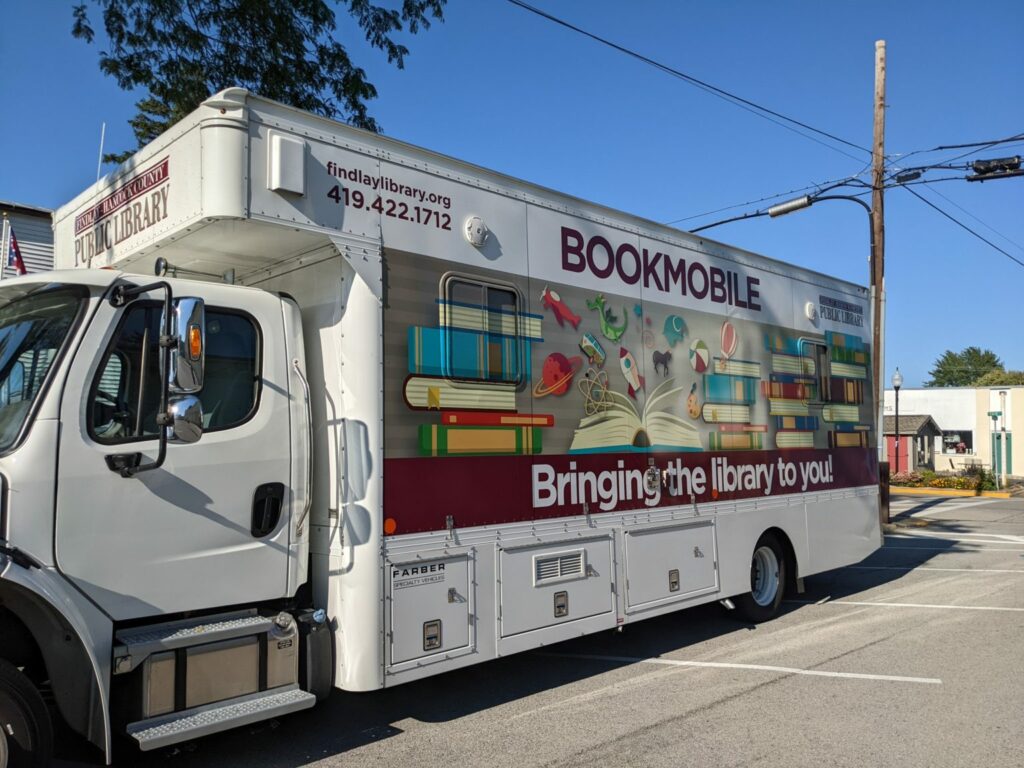
Some upgrades, like the Main Street flower planters, benches in honor of community residents, and a shop’s new green and white canopy, seemed to have a more personal touch. In Mount Blanchard, going small had big payoffs. Jackie Porcello said she thought the reasons might surprise us: “Small improvements and changes might not be noticed in a big busy town, but smallness has attributes. When there’s a new bench in town, everyone notices. That wouldn’t happen in a big town. But here, it’s a big deal.”
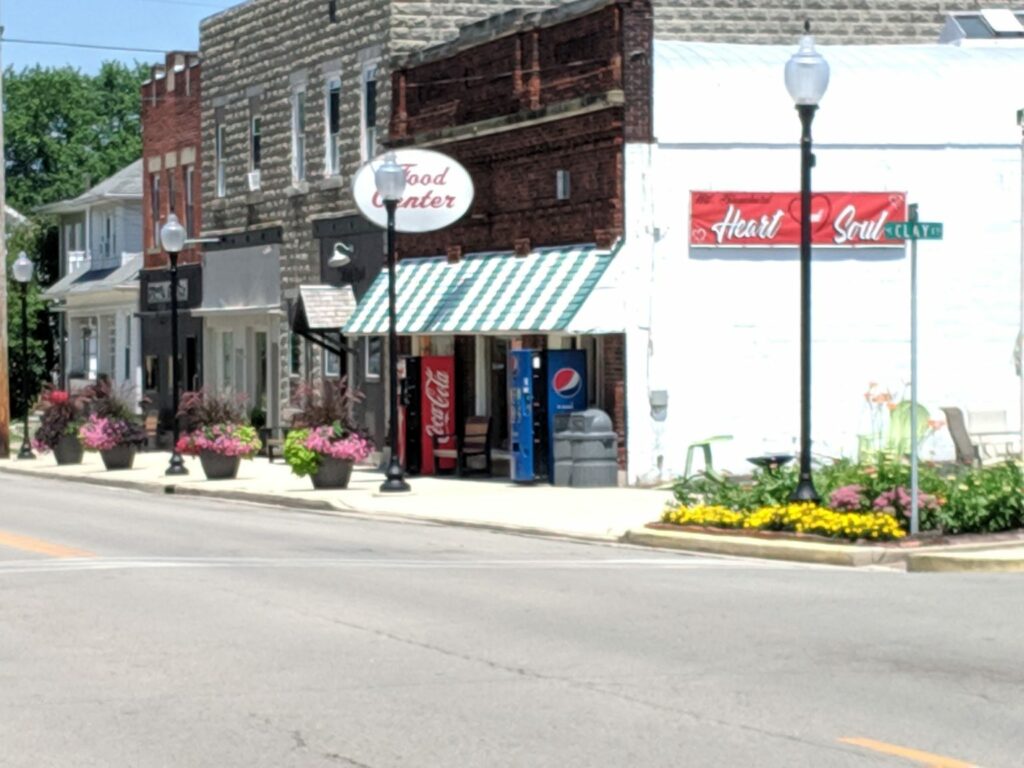
Porcello and another dozen Mount Blanchard residents explained to us that many of these improvements were the fruits of their CH&S project, a democratic process that engaged the town citizens for ideas, decisions (actual voting!) and taking action.
Here, briefly, are the steps that Mount Blanchard citizens took:
Build a team: A small, core group in Mount Blanchard signed on to do the work. They applied for funding from the Findlay-Hancock County Community Foundation (FHCCF), which had committed to many lift-all-towns efforts in their county, including CH&S funding for three rural towns. Community foundations are a story for another day soon, but the teaser is that we have seen the personal approach and support from community foundations help fundamentally recharge the economy and culture of the towns and regions they serve. The funds in this case would pay for CH&S operating expenses, a modest reservoir for projects, and a modestly-paid project coordinator, in this case Jackie Porcello.
Listen to the people: The team collected stories from residents about what they valued about their town — a lot of stories — to reach consensus on residents’ core principles. These became guardrails for staying on track as they sorted through specific ideas for improvements.
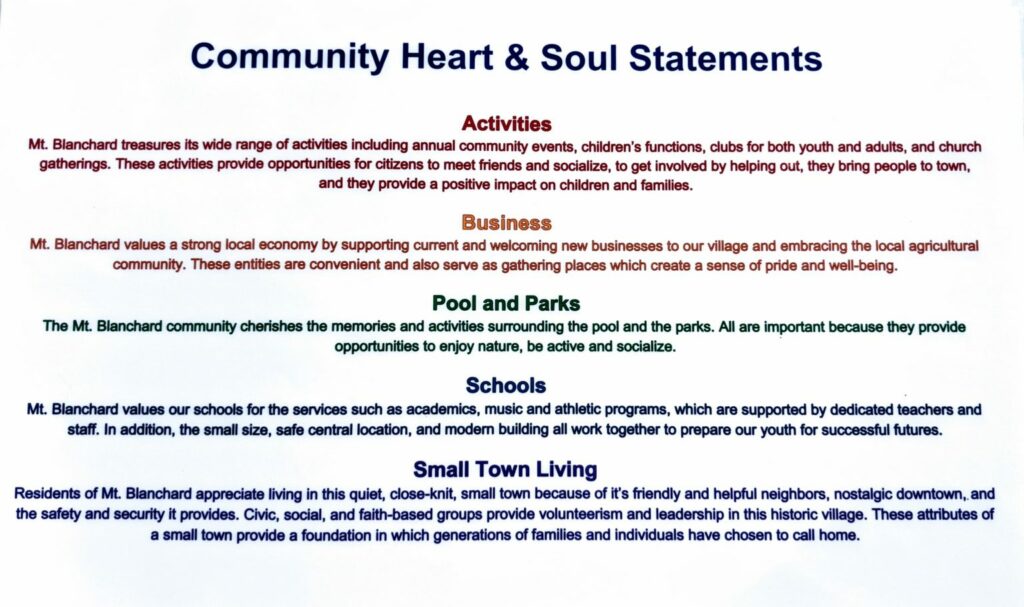
Collect ideas for projects: Next, the team blanketed the town, hitting popular spots like the Hair Stop salon, the school, the restaurant, and the Corner Dairy Bar to record people’s suggestions. They set up a sticky-note board in town for people to add comments. They held porch parties, block parties, and a town hall party.
The suggestions were specific and wide-ranging. Older people suggested a community center and curbs along the road. Younger ones wanted mulch on the playground. The teenagers were eager for a gaga pit. Gaga pit? For those who are wondering or are uninformed — like we were — picture an octagonal sumo-like ring, with raised sides, a sandy base, and a gaggle of kids inside. Try to hit someone with a very soft ball. If you’re hit, you’re out. Last one standing wins. Repeat. Chaotic, dirty, and fun.
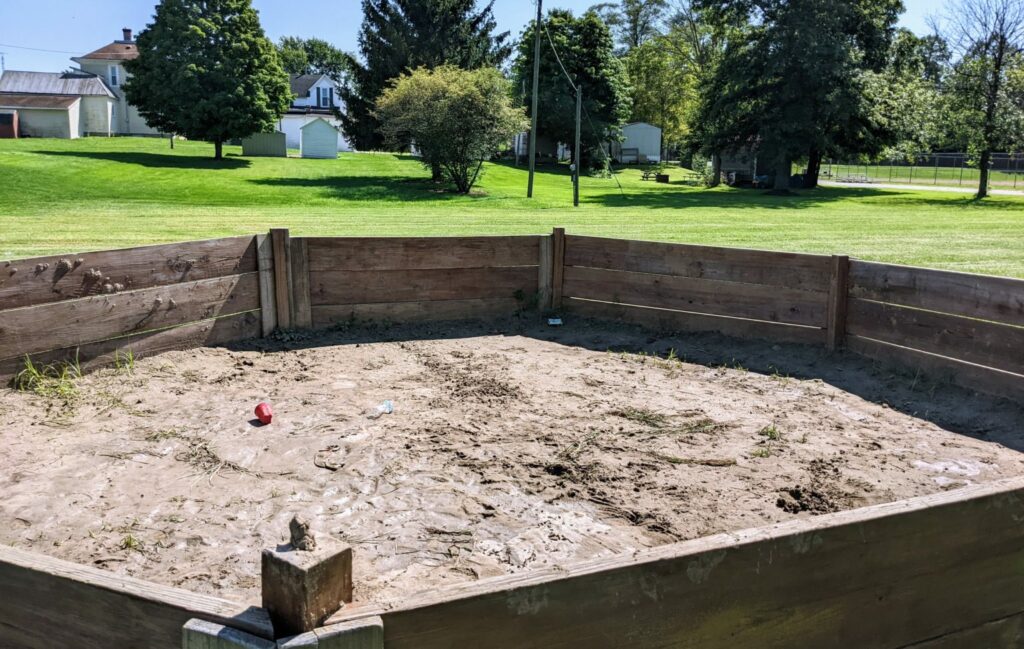
“We got some crazy ideas, like an international airport,” Jackie Porcello told me. And some skeptics’ grievances (“Yeah, we’ve heard this before; it’s never gonna happen.”). More attainable dreams came in, like festivals, a farmers market, covered areas with picnic tables or benches in the parks, striping the basketball courts, angled parking, a food pantry. All in all, the team logged every idea, more than 672 of them.
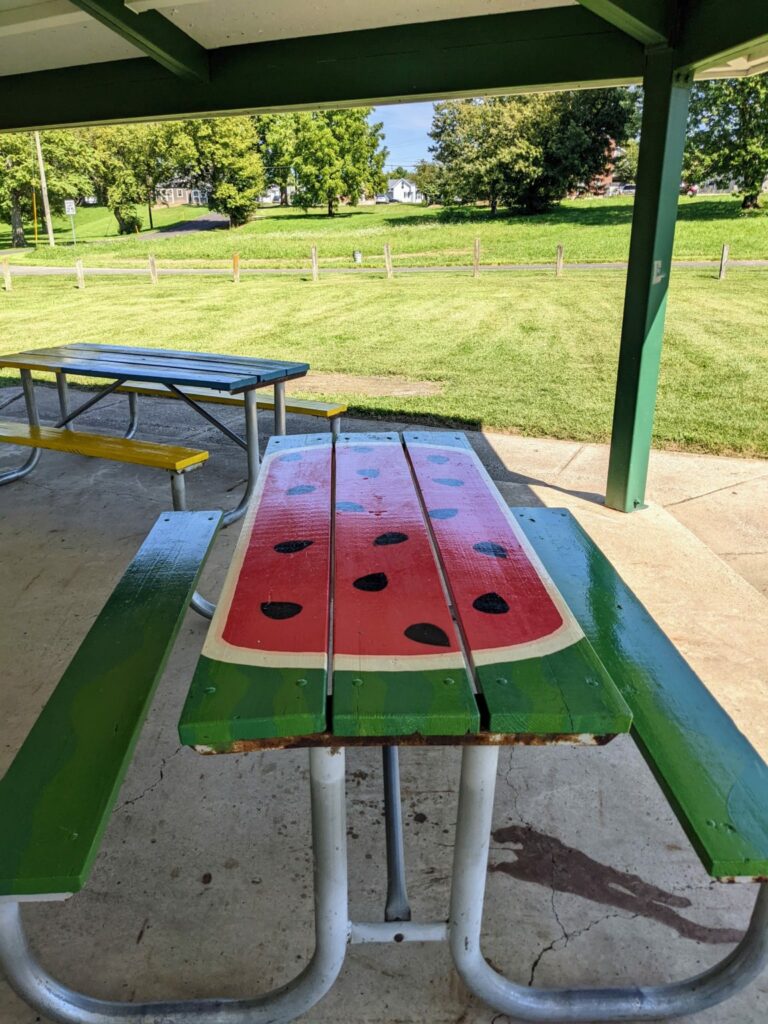
In a series of wintertime meetings, fueled by home-made dinners, people sifted through, organized and narrowed down the suggestions.
Vote on the options: Considering practicality, costs, satisfying a lot of people, and compromise, Mount Blanchard residents went for some easy wins: Sports equipment, like balls and rackets, for the courts and fields. A BBQ grill, which came in handy at the back-to-school lunch for the kids. The gaga pit! The team gave money to the kids from Future Farmers (FFA) to purchase wood, and the kids built the gaga pit. The angled parking on Main Street. Lines for the basketball court. These were all small-but-big achievements for Mount Blanchard. And people noticed.
A long the way of Mount Blanchard’s evolution, many civic and volunteer groups stepped up to support one another. Enthusiasm was infectious, and one thing often led to another. New leaders emerged. Volunteers poured out for clean-ups. Festivals multiplied: a Pumpkin Festival, Christmas Village, a Bluegrass Festival, a Heritage Festival.
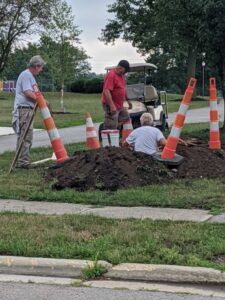
(Photo credit: Jackie Porcello)
One particularly charming story stood out to me from our conversations with the residents: When volunteers were clearing out the fields by the swimming pool, lo and behold, they uncovered what had been a baseball diamond. One man recounted, “I went back home and looked at my wife. I said, ‘You know what, honey? As many times as we went down that street, it turns out there’s another diamond down there!’” That find led to a new old-timers local baseball team, who joined the Ohio Village Muffins, the mid-19th century version of baseball that is a regional tradition, played in vintage outfits by old-time rules.
From one big or small improvement to the next, the culture of the town was changing. People were getting to know their neighbors through participation. They knew whom to call in a pinch. Collaborations were building.
Here is how I would describe what I heard from the Mount Blanchard residents:
Pride in the town: When things began looking better, people took better care. Vandalism declined. Clean up days continued to draw scores of volunteers; kids showed up with brooms. Even private homes and businesses seemed to perk up; buildings were painted, old tires disappeared, trees were planted.
Communication and collaborations: For local information, people watched the LED sign. There were some nice surprises. “We had the idea to put to up more flagpoles in veterans park,“ one woman told me. “And when we were talking about doing that, another group that we hadn’t even heard of stepped up to say, Hey, we want to help.”
On the personal side, people from CH&S who interviewed their neighbors for stories, themselves saw their hometowns in a new way. Porcello told us one story from an elderly woman who talked of her fondness for hearing the church bells. “I never would have known things like this about residents I barely knew. It makes you feel differently about your town,” Porcello said.
A new imagination. People were inspired by each other to start new projects. The residents would profit, but so might the town. Maybe a pretty Main St. would attract visitors and tourists, who would support business. Maybe new parks would attract families and gatherings. Maybe people would surprise themselves and become leaders.
That’s the story of Mount Blanchard and how they practiced democracy. Many citizens in a small town working together to make small, and ultimately big changes.

Deborah Fallows is a writer and a linguist. She has written for The Atlantic, National Geographic, Slate, The New York Times, The Washington Post, and The Washington Monthly. She is the author of three books including Our Towns: A 100,000 Mile Journey into the Heart of America (2018), a New York Times bestseller co-written with her husband, James Fallows. The HBO documentary, also called Our Towns, based on the book, is now streaming on HBO Max. Deborah and James founded the nonprofit Our Towns Civic Foundation to promote the ideas of resilience and renewal in towns across America.


